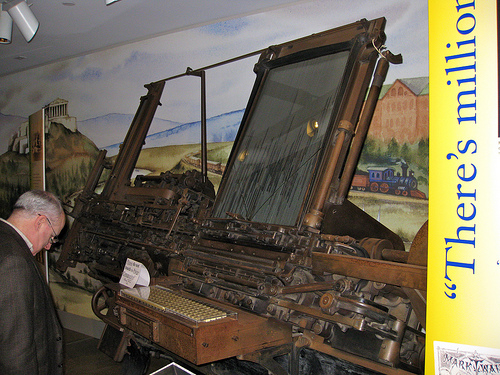
Robert McChesney (left) and John Nichols
What role should the government have in preserving public-interest journalism? If you’re a First Amendment absolutist (and I consider myself to be pretty close), you might immediately respond with a resounding “none.” Yet such purity has never been the reality in American life.
Heavy postal subsidies from the earliest days of the republic helped create the most vibrant newspaper and magazine industry in the world. To bring matters up to the present, media corporations are now given virtually free use of the broadcast airwaves, theoretically owned by all of us, with little expectation that they will fulfill the public-interest obligations that were once required of them.
Earlier today, John Nichols and Robert McChesney visited Northeastern to promote their new book, “The Death and Life of American Journalism: The Media Revolution That Will Begin the World Again.” (You can read excerpts of it here and here.) I won’t pretend to write an objective account — I introduced them, and we all said nice things about each other. Rather, I want to discuss briefly their idea that at a time when journalism is in crisis, government ought to step in and prop it up to the tune of some $30 billion a year — a number they say correlates, in 2010 dollars, with what was spent on postal subsidies in the 1840s.
To their credit, they do not propose taking taxpayer funds and handing them to Rupert Murdoch and Arthur Sulzberger. Instead, they would like to see a variety of initiatives that, properly implemented, would bolster journalism without raising the specter of government interference: greatly expanded support for public broadcasting with an arm’s-length funding mechanism; an AmeriCorps for young journalists; even a $200 tax credit for every family to spend on the news media of their choice.
And they are correct in asserting that other Western democracies, particularly the Scandinavian countries, subsidize their media to a far greater extent than we do without suffering any loss of freedom.
Yet I still worry that theirs is the wrong solution. Consider, for example, that non-profit organizations, including news operations, are forbidden from endorsing political candidates — a ban on free speech that dates back to 1954, when then-Senate majority leader Lyndon Johnson acted to silence the opposition back home in Texas. That underscores what I think is the real problem with government assistance: once you start relying on it, you are forever subject to the vagaries of the political moment.
Afterward I asked McChesney about an idea recently proposed by Dan Gillmor, best known as the author of “We the Media,” to emulate the original idea of postal subsidies by using government funds to pay for universal broadband access. As Gillmor sees it, that, combined with a guarantee of net neutrality, should be enough to allow market forces to do the rest.
“I think we need that no matter what,” McChesney replied. But he added there was “not a shred of evidence” that universal broadband access and net neutrality would be sufficient to guarantee a vibrant press.
Nichols and McChesney’s presentation combined gloom-and-doom with optimism for the future of journalism, if only the public can be mobilized. Like Clay Shirky, they think we have entered a post-advertising era in which it will prove impossible sustain journalism as a commercial enterprise. But whereas Shirky has called for a variety of commercial, non-profit and volunteer-driven experiments, Nichols and McChesney believe the public ought to pay more directly for what it needs to govern itself.
“We are at a 1776 moment,” Nichols said “It is your democracy that is threatened.”
Nichols and McChesney are co-founders of Free Press, an organization that is fighting the good fight on behalf of local ownership of radio and television stations and government guarantees for net neutrality. My reservations aside, Nichols and McChesney are making an important contribution to the discussion over paying for news, and I look forward to reading their book.





